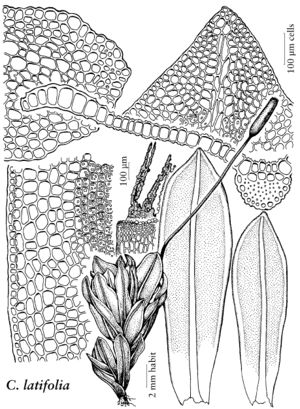Crumia
Canad. J. Bot. 44: 609, figs. 1–15. 1966 ,.
| Taxon | Illustrator ⠉ | |
|---|---|---|
 | Crumia latifolia | Patricia M. Eckel |
Plants forming cushions, green to reddish distally, blackish green to iridescent tan proximally. Stems to 3 mm, branching often; hyalodermis absent, sclerodermis absent, central strand absent or very weak; axillary hairs ca. 6 cells in length, proximal 1–2 cells yellowish. Leaves appressed, weakly contorted when dry, spreading when moist; spathulate, adaxial surface flat, shallowly channeled along costa, to 4 mm; base scarcely differentiated in shape, proximal margins bordered by a few rows of long-rectangular cells; margins recurved along 1 or both margins in the proximal 1/2, entire, bordered by ca. 6 rows of enlarged, rounded rhomboid to rectangular cells, except the marginal row; apex broadly acute to rounded-acute, usually broadly apiculate; costa percurrent or ending 1–2 cells below the apex, adaxial outgrowths absent, adaxial cells elongate in 5–6 rows, transverse-section semicircular, adaxial epidermis present, adaxial stereid band absent, guide cells 3–4 in 1 layer, hydroid strand absent, abaxial stereid band present, strong, semicircular in section, abaxial epidermis weakly developed; basal-cells differentiated medially, inflated-rectangular, slightly wider than the distal cells, 3–5: 1, walls of basal-cells thin, brown; distal medial cells hexagonal to shortly rectangular, 13–20 µm wide, 1–2: 1, 1-stratose; papillae small, simple to 2-fid, 8–12 per lumen, scattered, cell-walls thin, weakly convex on both sides. Specialized asexual reproduction absent. Sexual condition dioicous. Perichaetia terminal, interior leaves not sheathing, little different from cauline leaves. Seta ca. 1.4 mm. Capsule stegocarpous, theca cylindric, 2.5–3 mm, annulus of ca. 2 rows vesiculose cells; operculum conic, 0.8–1.1 mm; peristome teeth 16, cleft to near base into two branches, linear, rami much perforated and anastomosing, twisted very weakly counterclockwise, teeth ca. 200 µm. Calyptra cucullate. Spores ca. 15–18 µm. Laminal KOH color reaction reddish orange.
Distribution
w North America
Discussion
Species 1.
Crumia is a robust moss similar to Scopelophila in the often black or deep brown coloration of the plants, the lack of either a sclerodermis or a hyalodermis in the stem, the spathulate leaf shape and single costal stereid band, but differs in the presence of a stem central strand (though small or occasionally absent), a more strongly differentiated, intramarginal leaf border, and presence of a peristome (though rarely fruiting). Hennediella has bordered leaves but is red in KOH, not reddish orange, and has plane leaf margins with marginal cells not larger than the medial as seen in section. A second species, Crumia deciduidentata, was referred to Tortula by R. H. Zander (1993) on the basis of differences in the peristome, the awned perichaetial leaves, strong stem central strand, and presence of a hydroid strand in the costa.
Selected References
None.